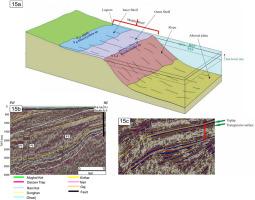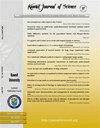A reappraisal of Mesozoic-Cenozoic sequence stratigraphy in Offshore Indus Basin, Pakistan
IF 1.2
4区 综合性期刊
Q3 MULTIDISCIPLINARY SCIENCES
引用次数: 0
Abstract
The Offshore Indus Basin is a passive continental margin and a frontier zone for hydrocarbon exploration based on structural and stratigraphic features observed on seismic data. In this study, the seismic and biostratigraphic framework is established using seismic data, geophysical well logs, along with biostratigraphic information to define the depositional sequences in the study region. A re-examination of the seismic data exhibits normal faults and a total of six seismic sequences ranging from Cretaceous to Quaternary. Nummulites atacicus, Nummulites globulus, Discocyclina sp., Miscellanea miscella, and Ranikothalia sp. are the major identified fauna in the Karachi South A1 well (2030–2724 m). The Miscellanea miscella, Ranikothalia, and Discocyclina sp. ages range from 55 to 56.5, 55–59, and 55–59 Ma respectively. Employing biostratigraphy, Ranikothalia/Miscellanea miscella/Discocyclina biozone (55–59 Ma), a single sequence, a third order cycle of deposition and transgressive and highstand system tracts have been recognized in the Karachi South A1 well. Linking biostratigraphic results to seismic stratigraphy indicates that the strata located in the range of 2030–2724 m is of the Ranikot (Paleocene) Formation and has been previously given Eocene age rather than the Paleocene using vintage seismic data. The environment of deposition of the Ranikot Formation in the Karachi South A1 well is the subtidal environment of the middle-shelf (30–45m depth) setting.

巴基斯坦近海印度河盆地中生代-新生代层序地层学再评价
近海印度河盆地是一个被动大陆边缘,也是根据地震数据观察到的结构和地层特征进行油气勘探的前沿地带。本研究利用地震数据、地球物理测井记录和生物地层学信息建立了地震和生物地层学框架,以确定研究区域的沉积序列。对地震数据的重新审查显示出正常断层和从白垩纪到第四纪的共六个地震序列。Nummulites atacicus、Nummulites globulus、Discocyclina sp.、Miscellanea miscella 和 Ranikothalia sp.是卡拉奇南 A1 井(2030-2724 米)发现的主要动物群。Miscellanea miscella、Ranikothalia 和 Discocyclina sp.的年龄分别为 55 至 56.5、55 至 59 和 55 至 59 Ma。根据生物地层学,卡拉奇南 A1 井确认了 Ranikothalia/Miscellanea miscella/Discocyclina 生物区(55-59 Ma)、单一序列、三阶沉积周期以及横断和高地系统道。将生物地层学结果与地震地层学联系起来表明,位于 2030-2724 米范围内的地层属于 Ranikot(古新世)地层,而以前使用的古老地震数据将其定为始新世而不是古新世。卡拉奇南 A1 井中 Ranikot 地层的沉积环境是中陆架(30-45 米深)的潮下环境。
本文章由计算机程序翻译,如有差异,请以英文原文为准。
求助全文
约1分钟内获得全文
求助全文
来源期刊

Kuwait Journal of Science
MULTIDISCIPLINARY SCIENCES-
CiteScore
1.60
自引率
28.60%
发文量
132
期刊介绍:
Kuwait Journal of Science (KJS) is indexed and abstracted by major publishing houses such as Chemical Abstract, Science Citation Index, Current contents, Mathematics Abstract, Micribiological Abstracts etc. KJS publishes peer-review articles in various fields of Science including Mathematics, Computer Science, Physics, Statistics, Biology, Chemistry and Earth & Environmental Sciences. In addition, it also aims to bring the results of scientific research carried out under a variety of intellectual traditions and organizations to the attention of specialized scholarly readership. As such, the publisher expects the submission of original manuscripts which contain analysis and solutions about important theoretical, empirical and normative issues.
 求助内容:
求助内容: 应助结果提醒方式:
应助结果提醒方式:


